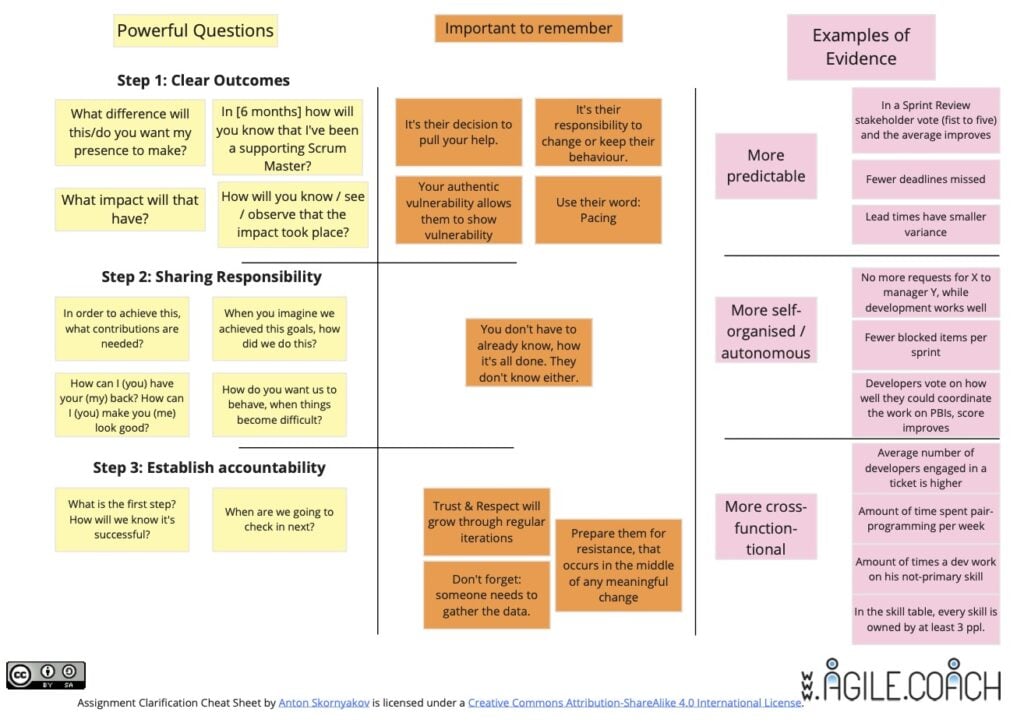I’ve facilitated my first Berlin Scrum Meetup yesterday and really love the experience.
Our first session is going to be about “Assignment Clarification” (German “Auftragsklärung”) of a Scrum Master. If you are just looking for the current Cheat Sheet click here.

Why does a Scrum Master need a clear assignment?
As a Scrum Master, you don’t have formal authority but are expected to have influence. Where does this influence come from? Your influence comes from the assignment that you are given by the organisation, your team or your product owner. Your ability to solicit an assignment and the process of continuously clarifying it is one of the most important coaching parts of your job.
But not only this. Most often people wonder, what does a Scrum Master do all day. Since they are comparing their work with development work. By creating clarity around your assignment you are automatically providing people with an understanding of what it is, that they are paying for when hiring a Scrum Master or an Agile Coach.
Process of soliciting a clear assignment
Step 1: Clear Outcomes

The first step of this conversation is to agree on middle- or long-term observable, verifiable outcomes of your work as a Scrum Master. There is a reason people hired you. There are current pains that people in the system you are working with are feeling. One useful question here could be:
What difference (or impact) would you like my presence to make?
In 6 months how will you know, that I’ve been a supportive Scrum Master?
Often the first answers to these questions aren’t very concrete enough, e.g: We are more predictable. Here you need to dig deeper. Often you will also need to give examples of evidence.
Evidence

It’s important to agree on collectable evidence, that will prove the outcomes or impacts you agree on. This is an area most people are not used to. The subject of your work as a Scrum Master is the system people are working in. So your goals are typically not 100 customers signed up for Product X but a meta-level above this, like the above example of predictability. So what could be a good evidence of predictability:
“We miss fewer deadlines (e.g. only 1 per 3 topics) and by smaller amounts of time (e.g. max 2 weeks).“
“In a Sprint Review stakeholder vote on predictability of the last 3 Sprints (fingers one to five) and the average improves to at least 3.5“
When reading these two examples you may notice that predictability means very different things to different stakeholders in different organisations. By going through this process of defining the evidence, you create further clarity on what it is, that you are trying to achieve and it enables you to go both next steps.
Once you have an outcome and know how you will see that it’s actually there, you need to check with each other. How does it feel? Is it clear enough and is it truly attractive? Sometimes you’ll find that now that you have such clarity around this outcome, another outcome is actually more important.
By the way, you can find many more examples of evidence and of powerful questions to find these together in the Cheat Sheet at the end of this article.
Step 2: Shared Responsibility

Now let’s say you have the outcome. And people involved in assignment clarification all feel it’s attractive to achieve it. The next question is:
Who needs to contribute to us achieving this outcome and how?
With a coachee that is just starting working with Scrum Masters, there is the misunderstanding that the Scrum Master will do some magic, [people often imagine some motivational talks like a sports-trainer to the team in movies.] and suddenly people behave differently. Apart from a few examples, it doesn’t work like this.
Scrum or Agile also means changing our behaviours. That’s typically hard (think: quitting smoking). And it won’t happen to the person changing their behaviour, it happens only by this person. They obviously can have support, that’s what a Scrum Master is for.
Some other powerful questions that may help you lead this conversation are:
Imagine we’ve achieved the goal. Who contributed to it and how?
How do we want us to behave if things become difficult?
Doing this you will often need to understand the underlying problem better, uncover different hypothesis for the root cause.
Once you have the feeling everyone feels engaged, understands their general role in achieving the outcome and has committed to contributing it you can move on.
Step 3: Accountability
The next question is, how will you see and measure progress on your way to achieving the longer-term goal. Here you want to agree on experiments with an outcome that may become visible in short term. For this typically there For our example of predictability (meaning missing fewer deadlines) this could mean:
Experiment: The team is reducing its Work-In-Progress limit for projects for 1 month. We expect to see a reduction in by how much we miss current deadlines. We’ll check it on date X.
The above is a very minimal description of an experiment to make it tangible enough in this blog post. However, there is much more to say about experiment design.
Most important parts of accountability are: We know what we will do, how everyone plans to contribute and when we’ll check the result together.
Iterative process of grows trust and understanding

As you notice from the last part of this description. Assignment clarification like the rest of your work as a Scrum Master is an iterative process. Through this, the trust of everyone is increased as is their understanding of their system of work.
Please tell us, whether you found this article and the Cheat-Sheet useful. If enough people do, we’ll make it more elaborate and easy to use.
Cheat Sheet

You can download the PDF Version of our Cheat Sheet here:
Hint for German speakers: Here’s another detailed article on the topic, including a video:
Liebe deutschsprachige Leser:
Update 2023: Hier im Artikel findet Ihr mehr zum Thema, auch mit Photos: Scrum Master Auftrag im Vorstellungsgespräch: Wie & warum?